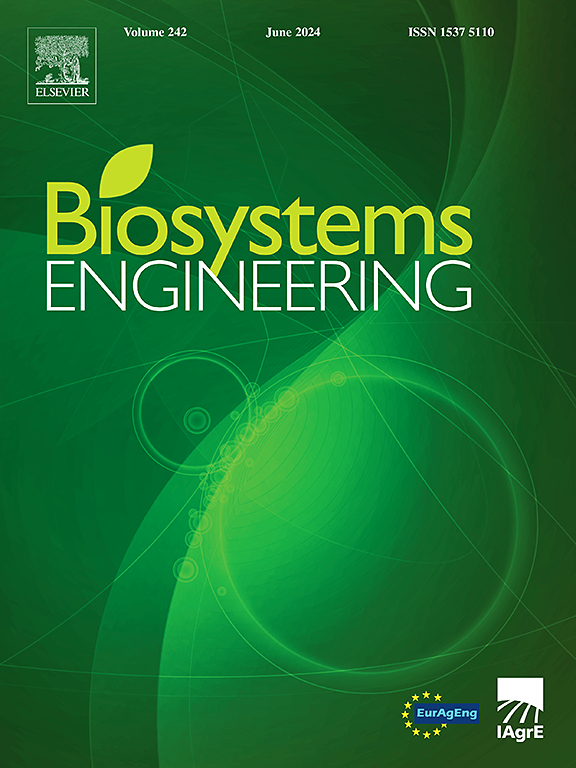pH改性对短期储存期间猪浆氨排放、温室气体排放和消毒的影响
IF 5.3
1区 农林科学
Q1 AGRICULTURAL ENGINEERING
引用次数: 0
摘要
储存是粪肥管理链的重要组成部分,可能会发生大量氨(NH3)和温室气体(GHG)的损失。改变pH值是一种很有前途的方法,可以实现浆液消毒,并为农民提供安全的有机肥料。此外,理想情况下,这种处理应能减少储存过程中NH3或温室气体的排放。因此,本研究的目的是评估pH改性对猪浆短期储存过程中NH3和温室气体排放的影响。考虑了三种处理策略:矿物酸化(pH 5),生物酸化(生物酸化;pH 5)和碱化(9.5)。造纸工业的副产品或富碳基质被用作矿物酸化的替代添加剂。结果表明,所有治疗策略均可减少大肠杆菌数量。然而,完全的浆液消毒(<;1000菌落形成单位(CFU) g−1浆液)只有在矿物酸化时才明显。与原浆相比,原浆(生物)酸化可减少85%的NH3排放,而碱化导致的NH3挥发与原浆相似。在储存过程中,添加糖刺激了甲烷(CH4)的排放,而碱化则导致了最小的CH4排放。用于泥浆酸化的酸副产物显着减少了二氧化碳(CO2)排放。即使考虑挥发NH3产生的间接氧化亚氮排放,泥浆碱化产生的温室气体排放总量也最低。结果表明,通过pH值改性对猪浆进行消毒的策略也有助于减少储存过程中NH3和/或温室气体的排放。本文章由计算机程序翻译,如有差异,请以英文原文为准。

Effect of pH modification on ammonia emissions, greenhouse gas emissions, and sanitisation of pig slurry during short-term storage
Storage is an important part of the manure management chain where considerable losses of ammonia (NH3) and greenhouse gases (GHG) can occur. Modification of the pH value is a promising approach to achieve slurry sanitisation and provide a safe organic fertiliser to farmers. Furthermore, such treatment should ideally induce a decrease of NH3 or GHG emissions during storage. Therefore, the aim of the present work was to assess the effect of pH modification on NH3 and GHG emissions during short-term storage of pig slurry. Three treatment strategies were considered: mineral acidification (pH 5), biological acidification (bio-acidification; pH 5) and alkalinisation (9.5). By-products from the paper-industry or carbon-rich substrates were used as alternative additives to mineral acidification. Results showed that all treatment strategies reduced E. coli numbers. However, complete slurry sanitisation (<1000 colony forming units (CFU) g−1 slurry) was evident only with mineral acidification. A reduction of >85 % NH3 emissions compared to raw slurry was obtained with slurry (bio)-acidification whereas alkalinisation led to NH3 volatilisation similar to raw slurry. Sugar addition stimulated methane (CH4) emissions during storage while alkalinisation led to minimal CH4 emissions. The acid by-product used for slurry acidification significantly reduced carbon dioxide (CO2) emissions. Slurry alkalinisation presented the lowest total GHG emissions, even when indirect nitrous oxide emissions were considered from volatilised NH3. Results suggest that strategies used to sanitise pig slurry through pH modification can also be beneficial to mitigate NH3 and/or GHG emissions during storage.
求助全文
通过发布文献求助,成功后即可免费获取论文全文。
去求助
来源期刊

Biosystems Engineering
农林科学-农业工程
CiteScore
10.60
自引率
7.80%
发文量
239
审稿时长
53 days
期刊介绍:
Biosystems Engineering publishes research in engineering and the physical sciences that represent advances in understanding or modelling of the performance of biological systems for sustainable developments in land use and the environment, agriculture and amenity, bioproduction processes and the food chain. The subject matter of the journal reflects the wide range and interdisciplinary nature of research in engineering for biological systems.
 求助内容:
求助内容: 应助结果提醒方式:
应助结果提醒方式:


